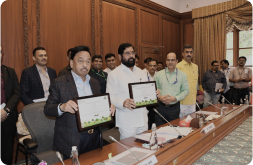










Project Target
99% Remaining
500
Trees Planted out of 50,000 Trees

Project Location:
In FY 2025-26 we planted 25,000 trees in Mawtari thaiang village in Ri-Bhoi district, Meghalaya. In addition to 25,000 trees which we planted in FY 2024-25 in the villages of Wahliewlong, Kartein, Umkrem, Nongshillong in Shillong, Meghalaya.
Project Aim
SDG
Why Trees?
Meghalaya stands out for its extraordinary biodiversity, encompassing sacred forests, ancient stone monoliths, and indigenous communities. Among these communities, the Khasi, Jaintia, and Garo indigenous groups are prominent, with the Khasi being the most populous. These groups have historically managed the forest lands using traditional forest management systems passed down through generations.
However, the forests of the Khasi hills have suffered significant degradation due to various human activities such as cultivation, timber extraction, mining, and development projects. Despite this, the region remains one of the wettest places on earth, earning its name "Meghalaya," which translates to "the abode of clouds" in Hindi and Sanskrit. This name reflects the high altitudes of the region, where forests literally meet the clouds.
The Meghalaya subtropical forest is home to an impressive array of wildlife, boasting over 110 mammal species. Among them are several threatened species, including the clouded leopard, sloth bear, Chinese pangolin, smooth-coated otter, and the Indian bison. Interestingly, researchers studying bison in Romania have discovered that a herd of 170 bison are the key to offsetting carbon dioxide equal to 2 millions cars. Bisons graze grasslands evenly, effectively dispersing seeds along the way and compacting the soil to prevent stored carbon from being released. This fertilises the soil and all of its life. The decline of these species has resulted in vast amounts of carbon being released back into the atmosphere. Preserving this biodiversity-rich ecosystem is crucial for both the indigenous communities that rely on it for their livelihoods and the global conservation efforts aimed at protecting endangered species.
Meghalaya also boasts a vibrant agrarian economy with a thriving commercial forestry industry. The International Journal of Plant & Soil states that 81% of the state population depends on agriculture as their primary source of livelihood.[1] However, farmers and communities in Shillong, Meghalaya struggle with economic constraints. They are burdened with limited knowledge about conservation agriculture, high input prices, and difficulties in marketing their produce.
Moreover, issues like water scarcity, invasive pests, and health concerns stemming from pesticide use have been identified in the region's agroecosystems. These challenges collectively impede agricultural productivity and livelihood sustainability.[2]
Research by Global Environmental Change states that, “Climate change exacerbates these challenges for Shillong's farmers, manifesting in erratic weather patterns, shifting rainfall trends, and more frequent extreme weather events. These climatic shifts adversely affect agricultural productivity, crop yields, and overall livelihood sustainability. Communities grapple with droughts, floods, crop diseases, and pests, further impeding their ability to attain viable harvests and income.”[3]
Tree plantation can play a pivotal role in addressing the multifaceted challenges faced by farmers and communities alike. Trees stabilise soil, reduce erosion, and enhance soil fertility through nutrient cycling, thereby mitigating the effects of water scarcity and soil degradation. Their role in mitigating the impact of climate change is also noteworthy. In the long run, trees help in stabilising weather patterns and reducing the frequency of extreme weather events.
Tree Species
In this tree plantation initiative, we have chosen the species that are well-suited to the climatic conditions of Shillong and offer benefits to the community. Selected species include Champa (Magnolia champaca), Bogi puma (Chukrasia spp.), Hollock tree (Terminalia myriocarpa), Teak (Tectona grandis) and Chaplaish jackfruit (Artocarpus chaplasa)
Social Impact
Tree plantation offers numerous benefits that span across multiple aspects.*
We involve the local communities across all our plantation sites, creating an additional source of income. They prepare the saplings in the nursery, look after transportation, plantation and maintenance. They can also supplement their income from fruits and other produce from our plantation.
Our inclusive policy guides us to generate equal employment opportunities for women as well. We hope that financial freedom will allow them to take charge of their household and be independent. Trees play a key role in absorption of carbon dioxide from the atmosphere. A mature tree can absorb up to 20 kg of CO2 each year. Planting trees keeps the temperature cool and reduces atmospheric stressors.
*The environmental benefits of the trees reach their full potential as they mature.
[1] Sri, K., Choudhury, A., Yumnam, A., Singh, R., & Dek, N. (2022). An assessment of constraints faced by cabbage growers in the east khasi hills district of meghalaya: india. International Journal of Plant & Soil Science, 722-729.
[2] Hollaus, A., Schunko, C., Weisshaidinger, R., Bala, P., & Vogl, C. (2022). Indigenous farmers’ perceptions of problems in the rice field agroecosystems in the upper baram, malaysia. Journal of Ethnobiology and Ethnomedicine, 18(1).
[3] Deressa, T., Hassan, R., Ringler, C., Alemu, T., & Yesuf, M. (2009). Determinants of farmers’ choice of adaptation methods to climate change in the nile basin of ethiopia. Global Environmental Change, 19(2), 248-255.
Social Impact of Growing Trees
Community Engagement
Tree planting initiatives often involve local communities, which can lead to greater community cohesion.
Ecological Education
Provides opportunities for community members, especially children, about the importance of environmental sustainability.
Urban Beautification
Trees contribute to the aesthetic enhancement of urban areas, making cities more pleasant and liveable.
Climate Resilience
By improving green cover, tree planting helps make communities more resilient against climate impacts like heatwaves.
Employment Creation
Planting trees creates employment for local community members like planting and maintenance, administrative roles, and more long-term jobs in management.
Wildlife Habitat
Trees provide critical habitats for various species of wildlife. Enhancing tree cover helps preserve biodiversity, which can be an ecological boon for local communities
Copyrights @ 2025 All rights reserved by Pangea EcoNetAssets Pvt Ltd.